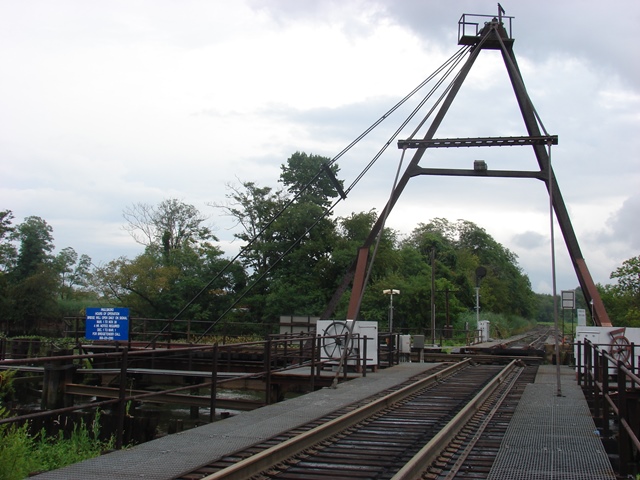We Recommend:
Bach Steel - Experts at historic truss bridge restoration.
BridgeHunter.com Phase 1 is released to the public! - Visit Now
Paulsboro Railroad Bridge
West Jersey and Seashore Railroad Mantua Creek Bridge

Primary Photographer(s): Patrick Harshbarger
Bridge Documented: July 11, 2010
Paulsboro: Gloucester County, New Jersey: United States
Metal Deck Girder, Movable: Swing and Approach Spans: Metal Stringer (Multi-Beam), Fixed
Not Available or Not Applicable
Not Available
Not Available
Not Available
1 Main Span(s)
Not Applicable

View Information About HSR Ratings
Bridge Documentation
This bridge no longer exists!
This was one of the most unusual movable bridges in the country, with its
unusual a-frame tower plus long rods for bracing. The type was known as a Shear
Pole type of swing bridge. A 1915 book, Design of Steel Bridges by F. C. Kunz
described the type as follows:
The design featured a single leaf turning
around a pivot at one end, the other end, while swinging, is suspended from the
top of a two-legged shear pole by rods which are attached to a pivot which is
vertically in the same line as the pivot below. The shear pole is stayed by guy
rods from the shore end. When the bridge is closed, it forms a simple span
supported at both ends. Note that this book also called it a "less important"
type of swing bridge that should only be used for temporary structures, a
reference to the fact that this bridge type had become archaic by 1915.
A video of this bridge in
operation is available on YouTube.
Some of the operating equipment
was unusual too, such as a wheel that looked like it came off a pirate ship. It
was destroyed by a train derailment in on November 30th, 2012. This bridge was
once not unique, with
several other
examples of this type once found. However at the time it was destroyed it
was the last of its kind in existence in the United States, a devastating loss
of heritage for this reason.
The bridge was further significant as an
example of one of the "primitive" movable bridge types that were common in the
19th century. Movable bridges of often overly complicated or very unusual design
were common in the 19th century (cities like Chicago had an amazing variety of
movable bridges types). Shear pole swing bridges are one example, other examples
were "jack-knife" or folding bridges, pontoon bridges, and others. With the
introduction of the modern trunnion and rolling lift bascule bridge forms, the
first modern Waddell-designed lift bridge, and general evolution and
improvements of traditional rim and center bearing swing bridges all occurring
in the 1890s, these new movable bridge forms were so much more reliable in
design that these "primitive" bridges were replaced at a very rapid rate
starting in the early 20th century. As such, that a bridge of this design
survived into the 21st century was quite remarkable, especially on an active
railroad line.
The tragedy of the loss of this bridge cannot be
understated. It would have been nice to see the bridge salvaged, repaired, and
placed on the ground as a sort of museum exhibit. The bridge was certainly
worthy of such an effort.
This bridge is tagged with the following special condition(s): Unorganized Photos
![]()
Photo Galleries and Videos: Paulsboro Railroad Bridge
Unorganized Photos
Original / Full Size PhotosA collection of overview and detail photos, presented as an unorganized and unlabeled collage and gallery. This gallery offers photos in the highest available resolution and file size in a touch-friendly popup viewer.
Alternatively, Browse Without Using Viewer
![]()
Unorganized Photos
Mobile Optimized PhotosA collection of overview and detail photos, presented as an unorganized and unlabeled collage and gallery. This gallery features data-friendly, fast-loading photos in a touch-friendly popup viewer.
Alternatively, Browse Without Using Viewer
![]()
Maps and Links: Paulsboro Railroad Bridge
This historic bridge has been demolished. This map is shown for reference purposes only.
Coordinates (Latitude, Longitude):
Search For Additional Bridge Listings:
Bridgehunter.com: View listed bridges within 0.5 miles (0.8 kilometers) of this bridge.
Bridgehunter.com: View listed bridges within 10 miles (16 kilometers) of this bridge.
Additional Maps:
Google Streetview (If Available)
GeoHack (Additional Links and Coordinates)
Apple Maps (Via DuckDuckGo Search)
Apple Maps (Apple devices only)
Android: Open Location In Your Map or GPS App
Flickr Gallery (Find Nearby Photos)
Wikimedia Commons (Find Nearby Photos)
Directions Via Sygic For Android
Directions Via Sygic For iOS and Android Dolphin Browser
USGS National Map (United States Only)
Historical USGS Topo Maps (United States Only)
Historic Aerials (United States Only)
CalTopo Maps (United States Only)

